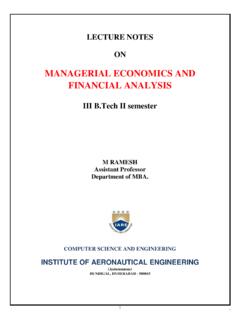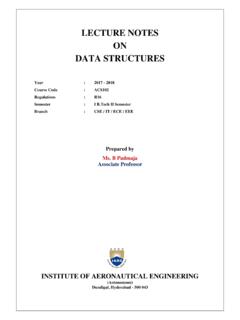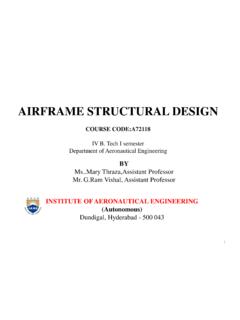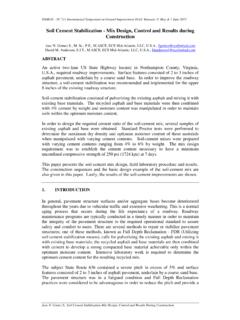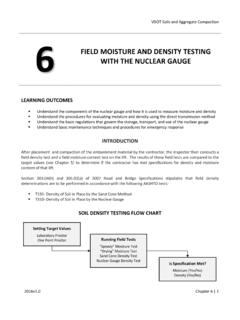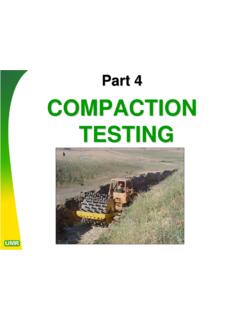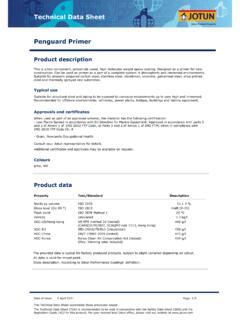Transcription of GEOTECHNICAL ENGINEERING LAB MANUAL
1 Page | 1 GEOTECHNICAL ENGINEERING LAB MANUAL Academic Year : 2017 - 2018 Course Code : ACE 105 Regulations : IARE R16 Class : IV Semester Branch : CIVIL ENGINEERING Department of Civil ENGINEERING INSTITUTE OF AERONAUTICAL ENGINEERING (Autonomous) Dundigal, Hyderabad 500 043 Page | 2 INSTITUTE OF AERONAUTICAL ENGINEERING (Autonomous) Dundigal, Hyderabad - 500 043 DEPARTMENT OF CIVIL ENGINEERING Program: Bachelor of Technology (B. Tech) VISION OF THE DEPARTMENT To produce eminent, competitive and dedicated civil engineers by imparting latest technical skills and ethical values to empower the students to play a key role in the planning and execution of infrastructural & developmental activities of the nation.
2 MISSION OF THE DEPARTMENT To provide exceptional education in civil ENGINEERING through quality teaching, state-of-the-art facilities and dynamic guidance to produce civil ENGINEERING graduates, who are professionally excellent to face complex technical challenges with creativity, leadership, ethics and social consciousness. Page | 3 INSTITUTE OF AERONAUTICAL ENGINEERING (Autonomous) Dundigal, Hyderabad - 500 043 DEPARTMENT OF CIVIL ENGINEERING Program: Bachelor of Technology (B. Tech) PROGRAM EDUCATIONAL OBJECTIVES (PEO s) 1. To impart proficiency in ENGINEERING knowledge and skills to analyze, design, build, maintain, or improve civil ENGINEERING based systems. (Professional Excellence) 2. To offer broad education and practical skills so that the students can carry out technical investigations within realistic constraints such as economic, environmental, societal, safety and sustainability.
3 (Understanding Socio-Economic Aspects) 3. To impart ability to collaborate with and function on multidisciplinary teams to offer ENGINEERING solutions to the society (Technical Collaboration) 4. To create interest in the students to engage in life-long learning in advanced areas of civil ENGINEERING and related fields. (Continued Self-Learning) 5. To educate the students in ethical values and social responsibility to use ENGINEERING techniques and modern tools necessary for civil ENGINEERING practice to serve the society effectively. (Effective Contribution to Society) Page | 4 INSTITUTE OF AERONAUTICAL ENGINEERING (Autonomous) Dundigal, Hyderabad - 500 043 DEPARTMENT OF CIVIL ENGINEERING Program: Bachelor of Technology (B.)
4 Tech) PROGRAM OUTCOMES (PO s) PO1 ENGINEERING knowledge: Apply the knowledge of mathematics, science, ENGINEERING fundamentals, and an ENGINEERING specialization to the solution of complex ENGINEERING problems. PO2 Problem analysis: Identify, formulate, review research literature, and analyze complex ENGINEERING problems reaching substantiated conclusions using first principles of mathematics, natural sciences, and ENGINEERING sciences. PO3 Design/development of solutions: Design solutions for complex ENGINEERING problems and design system components or processes that meet the specified needs with appropriate consideration for the public health and safety, and the cultural, societal, and environmental considerations.
5 PO4 Conduct investigations of complex problems: Use research-based knowledge and research methods including design of experiments, analysis and interpretation of data, and synthesis of the information to provide valid conclusions. PO5 Modern tool usage: Create, select, and apply appropriate techniques, resources, and modern ENGINEERING and IT tools including prediction and modeling to complex ENGINEERING activities with an understanding of the limitations. PO6 The engineer and society: Apply reasoning informed by the contextual knowledge to assess societal, health, safety, legal and cultural issues and the consequent responsibilities relevant to the professional ENGINEERING practice. PO7 Environment and sustainability: Understand the impact of the professional ENGINEERING solutions in societal and environmental contexts, and demonstrate the knowledge of, and need for sustainable development.
6 PO8 Ethics: Apply ethical principles and commit to professional ethics and responsibilities and norms of the ENGINEERING practice. PO9 Individual and team work: Function effectively as an individual, and as a member or leader in diverse teams, and in multidisciplinary settings. PO10 Communication: Communicate effectively on complex ENGINEERING activities with the ENGINEERING community and with society at large, such as, being able to comprehend and write effective reports and design documentation, make effective presentations, and give and receive clear instructions. PO11 Project management and finance: Demonstrate knowledge and understanding of the ENGINEERING and management principles and apply these to one s own work, as a member and leader in a team, to manage projects and in multidisciplinary environments.
7 PO12 Life-long learning: Recognize the need for, and have the preparation and ability to engage in independent and life-long learning in the broadest context of technological change. Page | 5 PROGRAM SPECIFIC OUTCOMES (PSO s) The Program Specific outcomes (PSO s) listed below were developed specifically to meet the Program Educational Objectives (PEO s). The focus of these PSO s is consistent with the set of required PO s identified in the NBA accreditation guidelines. The Civil ENGINEERING PSO s require that graduates receiving a Bachelor of Technology in Civil ENGINEERING degree from IARE demonstrate the following. PSO1. ENGINEERING KNOWLEDGE Graduates shall demonstrate sound knowledge in analysis, design, laboratory investigations and construction aspects of civil ENGINEERING infrastructure, along with good foundation in mathematics, basic sciences and technical communication.
8 PSO2. BROADNESS AND DIVERSITY Graduates will have a broad understanding of economical, environmental, societal, health and safety factors involved in infrastructural development, and shall demonstrate ability to function within multidisciplinary teams with competence in modern tool usage. PSO3. SELF-LEARNING AND SERVICE Graduates will be motivated for continuous self-learning in ENGINEERING practice and/or pursue research in advanced areas of civil ENGINEERING in order to offer ENGINEERING services to the society, ethically and responsibly. Page | 6 MANDATORY INSTRUCTIONS 1. Students should report to the labs concerned as per the timetable. 2. Record should be updated from time to time and the previous experiment must be signed by the faculty in charge concerned before attending the lab.
9 3. Students who turn up late to the labs will in no case be permitted to perform the experiment scheduled for the day. 4. After completion of the experiment, certification of the staff in-charge concerned in the observation book is necessary. 5. Students should bring a notebook of about 100 pages and should enter the readings/observations/results into the notebook while performing the experiment. 6. The record of observations along with the detailed experimental procedure of the experiment performed in the immediate previous session should be submitted and certified by the staff member in-charge. 7. Not more than FIVE students in a group are permitted to perform the experiment on a set up.
10 8. The group-wise division made in the beginning should be adhered to, and no mix up of student among different groups will be permitted later. 9. The components required pertaining to the experiment should be collected from Lab- in-charge after duly filling in the requisition form. 10. When the experiment is completed, students should disconnect the setup made by them, and should return all the components/instruments taken for the purpose. Page | 7 11. Any damage of the equipment or burnout of components will be viewed seriously either by putting penalty or by dismissing the total group of students from the lab for the semester/year. 12. Students should be present in the labs for the total scheduled duration.


